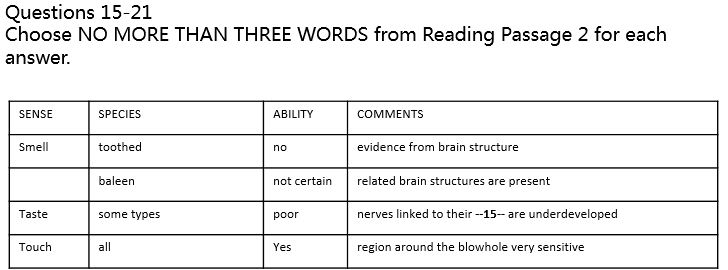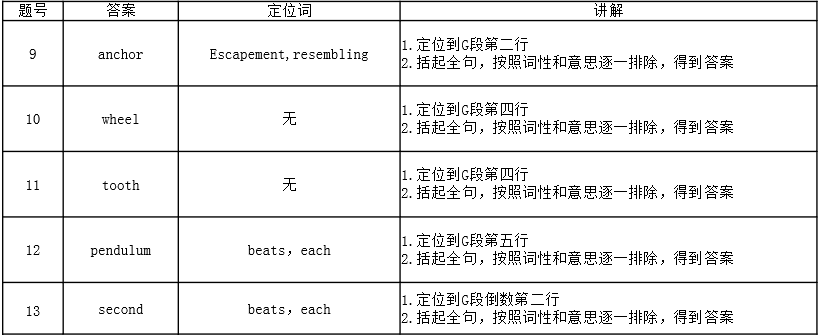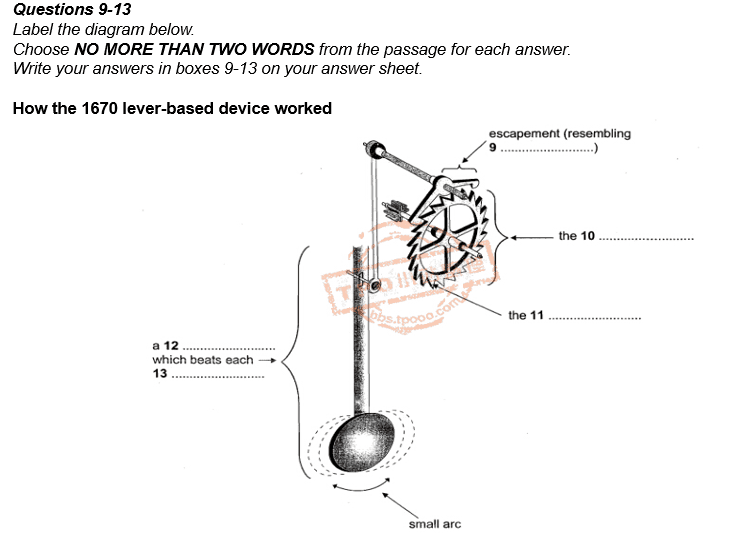雅思阅读表格填空题讲解:WhatDoWhalesFeel
如果你的剑桥雅思阅读已是烂熟于心,那么这一系列的雅思阅读机经真题真的很适合你,今天小编给大家带来了雅思阅读表格填空题讲解--What Do Whales Feel,希望能够帮助到大家,下面小编就和大家分享,来欣赏一下吧。
雅思阅读表格填空题讲解--What Do Whales Feel?
What Do Whales Feel?
Some of the senses that we and other terrestrial mammals take for granted are either reduced or absent in cetaceans or fail to function well in water. For example, it appears from their brain structure that toothed species are unable to smell. Baleen species, on the other hand, appear to have some related brain structures but it is not known whether these are functional. It has been speculated that, as the blowholes evolved and migrated to the top of the head, the neural pathways serving sense of smell may have been nearly all sacrificed. Similarly, although at least some cetaceans have taste buds, the nerves serving these have degenerated or are rudimentary.
The sense of touch has sometimes been described as weak too, but this view is probably mistaken. Trainers of captive dolphins and small whales often remark on their animals’ responsiveness to being touched or rubbed, and both captive and free-ranging cetacean individuals of all species (particularly adults and calves, or members of the same subgroup) appear to make frequent contact. This contact may help to maintain order within a group, and stroking or touching are part of the courtship ritual in most species. The area around the blowhole is also particularly sensitive and captive animals often object strongly to being touched there.
The sense of vision is developed to different degrees in different species. Baleen species studied at close quarters underwater – specifically a grey whale calf in captivity for a year, and free-ranging right whales and humpback whales studied and filmed off Argentina and Hawaii – have obviously tracked objects with vision under-water, and they can apparently see moderately well both in water and in air. However, the position of the eyes so restricts the field of vision in baleen whales that they probably do not have stereoscopic vision.
On the other hand, the position of the eyes in most dolphins and porpoises suggests that they have stereoscopic vision forward and downward. Eye position in freshwater dolphins, which often swim on their side or upside down while feeding, suggests that what vision they have is stereoscopic forward and upward. By comparison, the bottlenose dolphin has extremely keen vision in water. Judging from the way it watches and tracks airborne flying fish, it can apparently see fairly well through the air–water interface as well. And although preliminary experimental evidence suggests that their in-air vision is poor, the accuracy with which dolphins leap high to take small fish out of a trainer’s hand provides anecdotal evidence to the contrary.
Such variation can no doubt be explained with reference to the habitats in which individual species have developed. For example, vision is obviously more useful to species inhabiting clear open waters than to those living in turbid rivers and flooded plains. The South American boutu and Chinese beiji, for instance, appear to have very limited vision, and the Indian susus are blind, their eyes reduced to slits that probably allow them to sense only the direction and intensity of light.
Although the senses of taste and smell appear to have deteriorated, and vision in water appears to be uncertain, such weaknesses are more than compensated for by cetaceans’ well-developed acoustic sense. Most species are highly vocal, although they vary in the range of sounds they produce, and many forage for food using echolocation. Large baleen whales primarily use the lower frequencies and are often limited in their repertoire. Notable exceptions are the nearly song-like choruses of bowhead whales in summer and the complex, haunting utterances of the humpback whales. Toothed species in general employ more of the frequency spectrum, and produce a wider variety of sounds, than baleen species (though the sperm whale apparently produces a monotonous series of high-energy clicks and little else). Some of the more complicated sounds are clearly communicative, although what role they may play in the social life and ‘culture’ of cetaceans has been more the subject of wild speculation than of solid science.
真题讲解:

长难句练习:
1. Trainers of captive dolphins and small whales often remark on their animals' responsiveness to being touched or rubbed, and both captive and freeranging cetacean individuals of all species (particularly adults and calves, or members of the same subgroup)
参考译文:训练者捕获海豚和小鲸鱼经常评论它们的动物反映当被抚摸或是摩擦的时候,并且无论是捕获还是放养的所有种类的鲸类个体(尤其是成年鲸和幼仔,或是用一个子群中的成员)表现出频繁的接触。
2. By comparison, the bottlenose dolphin has extremely keen vision in water. From the way it watches and tracks airborne flying fish, it can apparently see fairly well through the air-water interface as well.
参考译文:相反的是,宽吻海豚在水中视力就很敏锐,而从它观察及追踪空中飞鱼的方式来看,它在水天交界面的视力也相当好。
知识点:现在分词做原因状语
1)主语要一致:分词短语的逻辑主语与句子主语要一致
2)独立分词结构:有时候分词的动作与谓语动作不是同一主语发出的,这时分词可以带上自己的逻辑主语,就形成了“名词/代词+分词短语”的结构,即所谓的独立分词结构。例如It being so nice a day, we go out for a walk.
3. Although the senses of taste and smell appear to have deteriorated, and vision in water appears to be uncertain, such weaknesses are more than compensated for by cetaceans’ well-developed acoustic sense.”
参考译文:尽管鲸鱼的味觉和嗅觉严重衰退,在水中的视觉又不那么确定,然而这些缺陷完全可以被他们那高度发达的听觉系统所弥补。
知识点:more than的用法
1.在口语当中,more than通常表示“极其;非常”。
2.More than 还有“超出;超过”的意思。
雅思阅读流程图填空题讲解--A Chronicle of Timekeeping
A Chronicle of Timekeeping
A
According to archaeological evidence, at least 5, 000 years ago, and long before the advent of the Roman Empire, the Babylonians began to measure time, introducing calendars to co-ordinate communal activities, to plan the shipment of goods and, in particular, to regulate planting and harvesting. They based their calendars on three natural cycles: the solar day, marked by the successive periods of light and darkness as the earth rotates on its axis; the lunar month, following the phases of the moon as it orbits the earth; and the solar year, defined by the changing seasons that accompany our planet's revolution around the sun.
B
Before the invention of artificial light, the moon had greater social impact. And, for those living near the equator in particular, its waxing and waning was more conspicuous than the passing of the seasons. Hence, the calendars that were developed at the lower latitudes were influenced more by the lunar cycle than by the solar year. In more northern climes, however, where seasonal agriculture was practiced, the solar year became more crucial. As the Roman Empire expanded northward, it organised its activity chart for the most part around the solar year.
C
Centuries before the Roman Empire, the Egyptians had formulated a municipal calendar having 12 months of 30 days, with five days added to approximate the solar year. Each period of ten days was marked by the appearance of special groups of stars called decans. At the rise of the star Sirius just before sunrise, which occurred around the all-important annual flooding of the Nile, 12 decans could be seen spanning the heavens. The cosmic significance the Egyptians placed in the 12 decans led them to develop a system in which each interval of darkness (and later, each interval of daylight) was divided into a dozen equal parts. These periods became known as temporal hours because their duration varied according to the changing length of days and nights with the passing of the seasons. Summer hours were long, winter ones short; only at the spring and autumn equinoxes were the hours of daylight and darkness equal. Temporal hours, which were first adopted by the Greeks and then the Romans, who disseminated them through Europe, remained in use for more than 2, 500 years.
D
In order to track temporal hours during the day, inventors created sundials, which indicate time by the length or direction of the sun's shadow. The sundial's counterpart, the water clock, was designed to measure temporal hours at night. One of the first water clocks was a basin with a small hole near the bottom through which the water dripped out. The falling water level denoted the passing hour as it dipped below hour lines inscribed on the inner surface. Although these devices performed satisfactorily around the Mediterranean, they could not always be depended on in the cloudy and often freezing weather of northern Europe.
E
The advent of the mechanical clock meant that although it could be adjusted to maintain temporal hours, it was naturally suited to keeping equal ones. With these, however, arose the question of when to begin counting, and so, in the early 14th century, a number of systems evolved. The schemes that divided the day into 24 equal parts varied according to the start of the count: Italian hours began at sunset, Babylonian hours at sunrise, astronomical hours at midday and 'great clock' hours, used for some large public clocks in Germany, at midnight. Eventually these were superseded by 'small clock', or French, hours, which split the day into two 12-hour periods commencing at midnight.
F
The earliest recorded weight-driven mechanical clock was built in 1283 in Bedfordshire in England. The revolutionary aspect of this new timekeeper was neither the descending weight that provided its motive force nor the gear wheels (which had been around for at least 1, 300 years) that transferred the power; it was the part called the escapement. In the early 1400s came the invention of the coiled spring or fuses which maintained constant force to the gear wheels of the timekeeper despite the changing tension of its mainspring. By the 16th century, a pendulum clock had been devised, but the pendulum swung in a large arc and thus was not very efficient.
G
To address this, a variation on the original escapement was invented in 1670, in England. It was called the anchor escapement, which was a lever-based device shaped like a ship's anchor. The motion of a pendulum rocks this device so that it catches and then releases each tooth of the escape wheel, in turn allowing it to turn a precise amount. Unlike the original form used in early pendulum clocks, the anchor escapement permitted the pendulum to travel in a very small arc. Moreover, this invention allowed the use of a long pendulum which could beat once a second and thus led to the development of a new floor-standing case design, which became known as the grandfather clock.
H
Today, highly accurate timekeeping instruments set the beat for most electronic devices. Nearly all computers contain a quartz-crystal clock to regulate their operation. Moreover, not only do time signals beamed down from Global Positioning System satellites calibrate the functions of precision navigation equipment, they do so as well for mobile phones, instant stock-trading systems and nationwide power-distribution grids. So integral have these time-based technologies become to day-to-day existence that our dependency on them is recognized only when they fail to work.
真题解析:


长难句练习:
1. They based their calendars on three natural cycles: the solar day, marked by the successive periods of light and darkness; the lunar month, following the phases of the moon; and the solar year, defined by the changing seasons.
参考译文:古巴比伦人的历法是根据三个自然循环建立的:太阳日(根据白天和黑夜接替的周期而来)、太阴月(由月月相变化而来),以及太阳年(根据四季变化来界定)。
知识点:
主从复合句
含有两套或更多的主谓结构,其中有一个是主要的主谓结构,其他主谓结构从属于它并且担任起句子成分。
①They believe that the computer will finally take the place of human beings.
②He asked me where he could get such medicine.
2. Temporal hours, which were first adopted by the Greeks and then the Romans, who disseminated them through Europe, remained in use for more than 2,500 years.
参考译文:日光时先是被希腊人采用,后来被将它们传播到整个欧洲的罗马人采用,在超过2,500年的时间里,它一直被人们使用着。
知识点:此句包含两个定语从句:which引导的从句修饰temporal hours,who引导的从句修饰the romans。句子的主干是temporal hours remained in use for more than 2,500 years.
3. The revolutionary aspect of this new timekeeper was neither the descending weight that provided its motive force nor the gear wheels (which had been around for at least 1,300 years) that transferred the power; it was the part called the escapement.
参考译文:这种新型计时器所具有的革命意义既不在于依靠向下的重力提供起动力,也不在于依靠齿轮(至少有1300年的使用历史)传递动力,而在于它使用了一个叫做擒纵机构棘轮装置的部件。
知识点:这句话的主干是主系表结构,不过有两个并列的表语。主语是The revolutionary aspect,系动词是was,表语是neither the descending weight nor the gear wheels。第一个that引导定语从句修饰weight,括号里的句子做插入语,是对gear wheels的补充说明,that引导定语从句修饰gear wheels,分号后面是一个简单的句子。
雅思阅读表格填空题讲解相关文章:
★ 雅思写作提高方法

